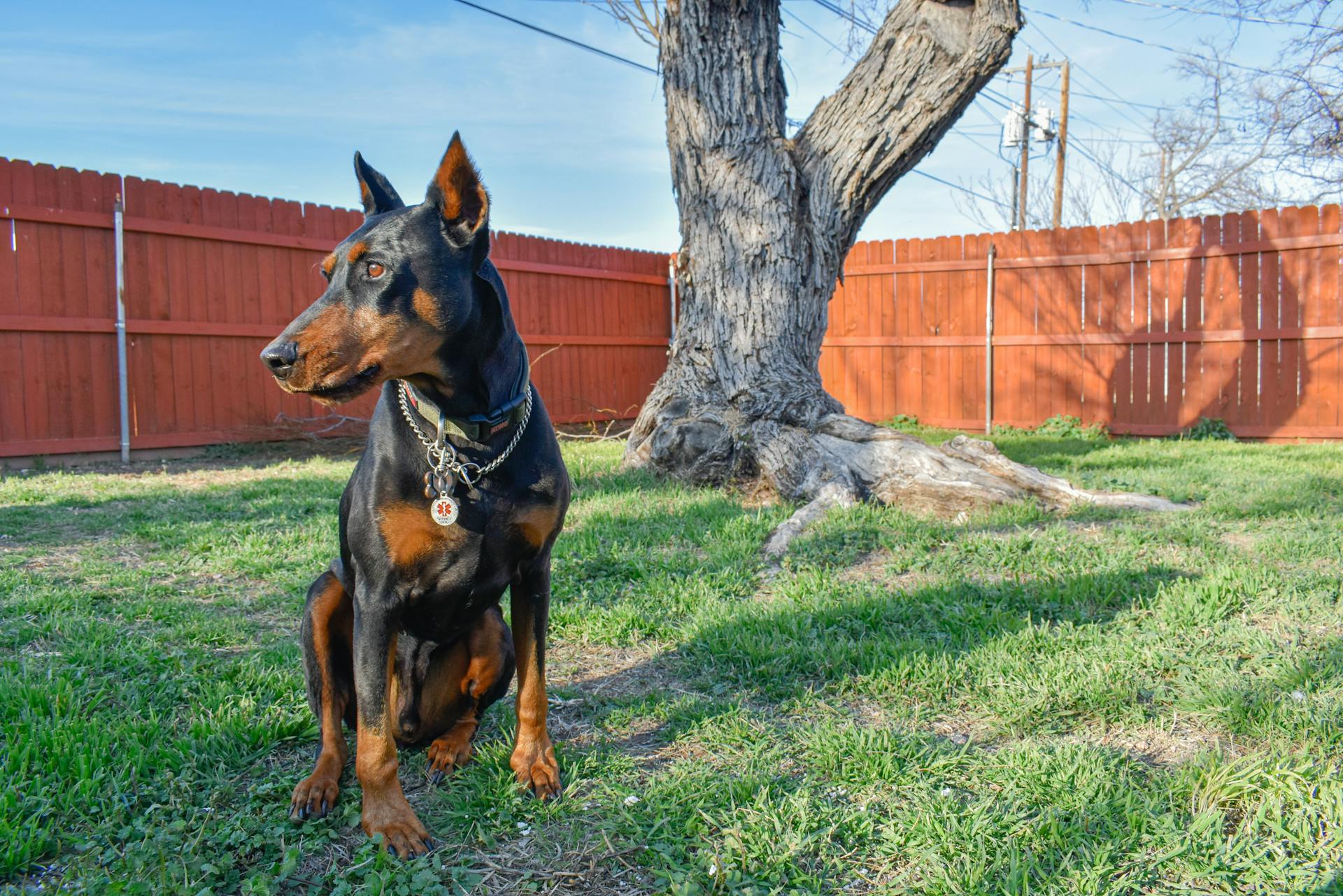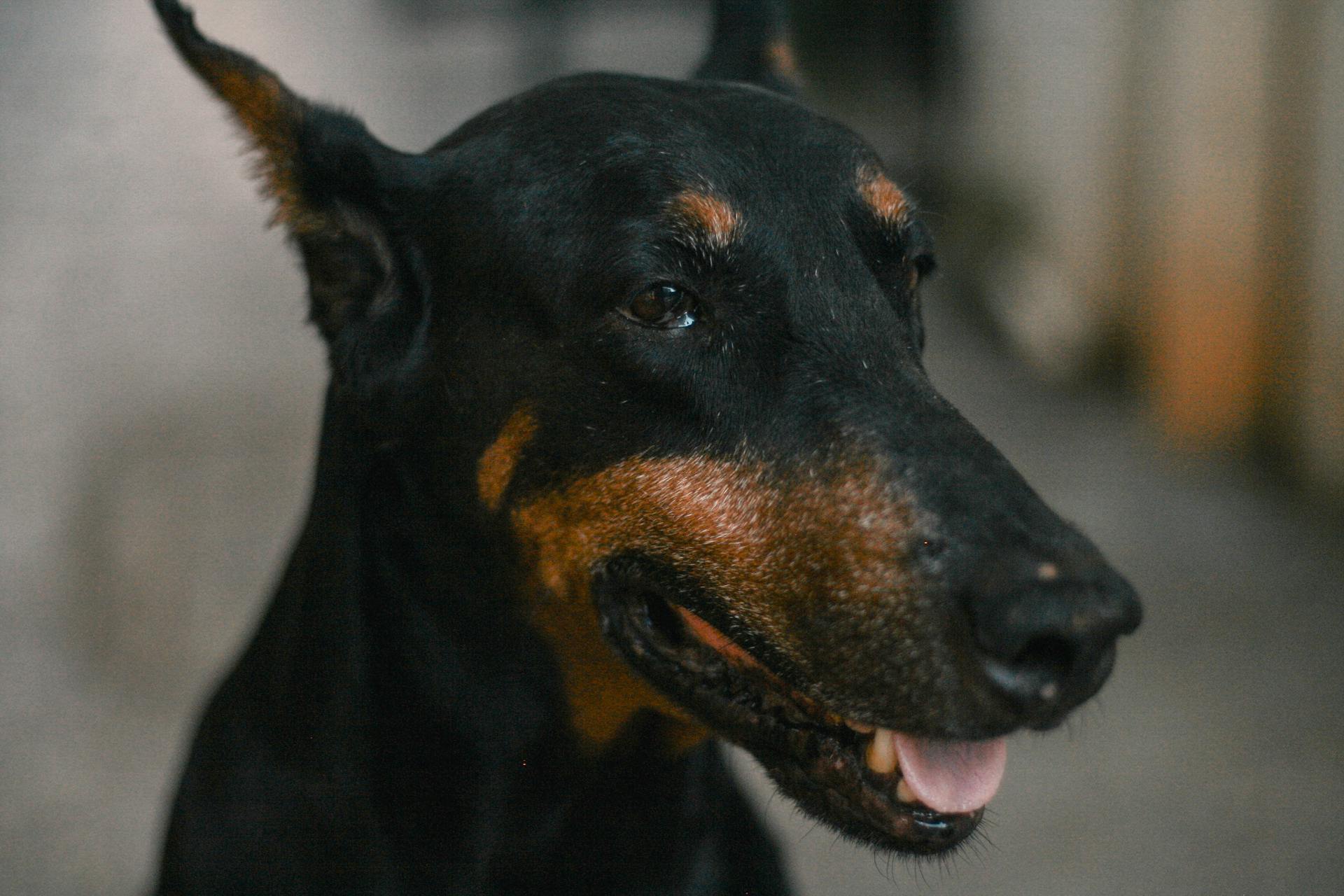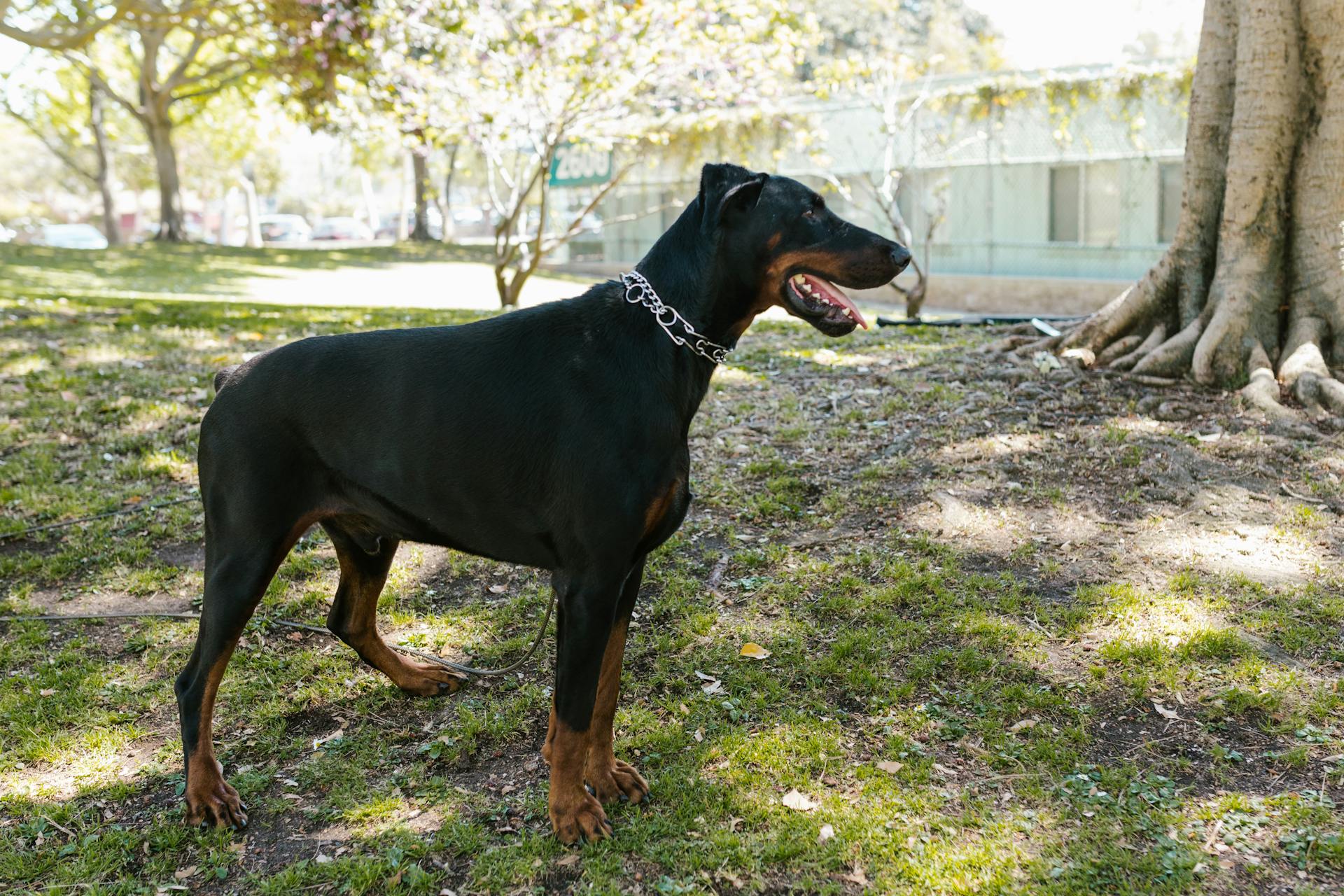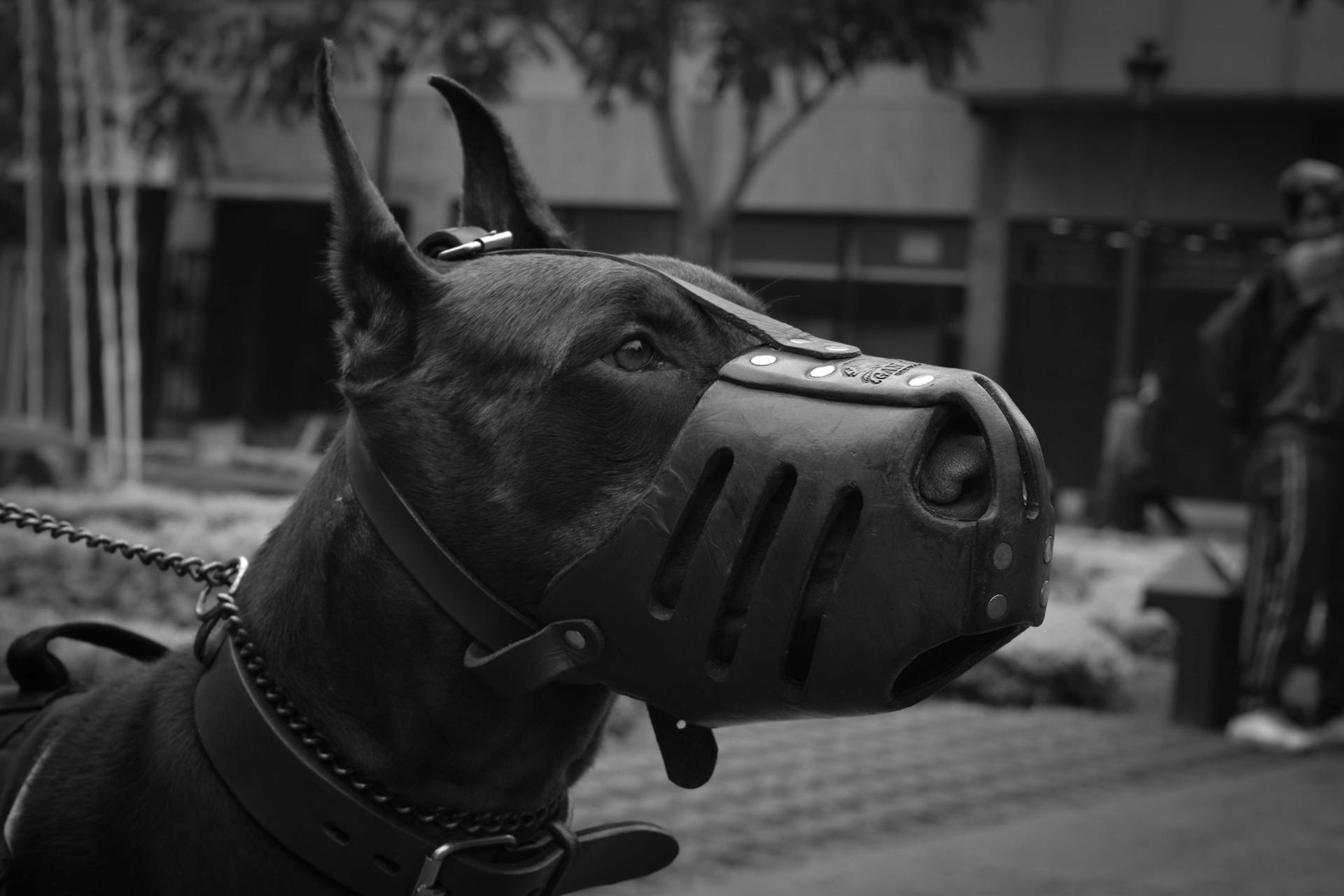
The Doberman Pinscher has a long history of tail docking, a practice that dates back to the breed's origins in the late 19th century.
The primary reason for tail docking was to prevent injury to the Doberman Pinscher's tail, which was considered a liability in the breed's original purpose as a guard dog and police dog.
However, the risks associated with tail docking far outweigh any potential benefits.
The practice of docking a Doberman Pinscher's tail is now largely considered unnecessary and inhumane, with many veterinarians and animal welfare organizations speaking out against it.
For your interest: Doberman Guard Dog Training
Breed Standard and History
The Doberman Pinscher breed has a rich history dating back to the 19th century. Breeding began with Karl Friedrich Louis Dobermann's goal to create a guardian dog.
The breed standard for Doberman Pinschers emphasizes a muscular build and athletic ability. This is reflected in their original purpose as guard dogs and police dogs.
In the early 20th century, tail docking became a common practice in the breed. This was done to prevent injury and improve the dog's appearance, as stated in some breed clubs' guidelines.
Expand your knowledge: Pinscher Miniatura
The Breed Standard
The breed standard is a document that outlines the ideal characteristics of a particular breed, primarily used by breed conformation judges in dog shows.
There are two major breed standards for the Doberman.
The AKC breed standard, used in the U.S., requires a docked tail that appears to be a continuation of the spine.
The breed standard used in Europe, the Americas, Caribbean, Asia, Africa, and Oceania, requires a natural tail that is ideally carried high in a slight curve.
Both breed standards consider a tail outside of their requirements a fault.
Remember, the breed standard only matters if you plan to compete in breed conformation shows with your dog.
Take a look at this: Doberman Pinscher Standard
Dog Breeds
Dog breeds come in all shapes and sizes, and one interesting aspect is how some breeds are naturally born without tails. This is due to a genetic mutation, C189G, which affects the length of their tail.
Some breeds that are naturally docked due to this mutation include the Australian Shepherd, Australian Stumpy Tail Cattle Dog, and the Schipperke. These breeds have a naturally short tail when born.
The Australian Shepherd, for example, is a highly intelligent breed that's often used as a herding dog. They're known for their agility and obedience.
The following breeds are naturally born without tails:
- Australian Shepherd
- Australian Stumpy Tail Cattle Dog
- Brittany Spaniel
- Danish Swedish Farmdog
- Jack Russell Terrier
- Pembroke Welsh Corgi
- Schipperke
What's in Dogs?
Dogs are often associated with specific breeds, each with its unique characteristics and features. Some breeds have undergone tail docking, a procedure where a part of the tail is amputated for cosmetic reasons.
Tail docking is a common practice in breeds like Doberman Pinschers, German Shorthaired Pointers, Miniature Schnauzers, Cocker Spaniels, and Rottweilers.
The procedure is typically done without anesthesia during the first five days of a puppy's life, which can be very painful for dogs. This practice is becoming less common and is considered outdated.
Some countries have banned tail docking, including Australia and much of Europe, including the United Kingdom. The American Veterinary Medical Association opposes cosmetic tail docking and recommends removing it from breed standards.
A fresh viewpoint: Tail Docking Ear Cropping
Reasons for Docking
Tail docking is done for only certain breeds of dogs to meet a breed standard, as defined by kennel clubs like the American Kennel Club (AKC) in the United States.
The AKC breed standard is the breeder's blueprint to which all dogs of that breed are compared, and it's used by judges to determine the best entrants that represent that breed.
Some dog breeds, like the Doberman Pinscher, German Shorthaired Pointer, and Miniature Schnauzer, have their tails docked to meet the AKC breed standard.
Reasons for Docking Dog Tails
Tail docking is done for only certain breeds of dogs to meet a breed standard. A breed standard defines the accepted appearance, gait, and temperament of a specific dog breed.
Some dog breeds require docking to meet the AKC breed standard, including the Doberman Pinscher, German Shorthaired Pointer, and Miniature Schnauzer. These breeds have specific requirements for tail docking.
The breed standard for the Doberman Pinscher states that the tail must be docked to the second joint. The breed standard for the German Shorthaired Pointer requires 60% of the original tail to be removed.
Advocates of tail docking often cite a reduced incidence of tail injuries in working and hunting dogs. A study found that dogs with docked tails were less likely to experience a tail injury, but the incidence of tail injury is already very low.
Hind-end hygiene is an important issue for some long-haired breeds, and docking the tail can minimize the risk of feces getting stuck in the fur. However, this does not prevent fecal contamination of the fur on the backs of the thighs and other areas.
Explore further: German Doberman Pinscher
Pain and Discomfort
Removing a Doberman's tail is almost never medically necessary, especially when it's typically done at just a few days old. Many see this as completely unnecessary.
Puppies vocalise intensely, or "shriek", during the tail docking procedure, indicating pain. This was observed in a study of 50 tail dockings.
Dogs may experience ongoing increased sensitivity to pain in their tail stub or even phantom pains as an adult. This suggests that the procedure can have long-lasting effects on their comfort.
Research shows that an intact tail is unlikely to become injured, and if it does, injuries are usually minor and heal easily. This makes the procedure seem even more unnecessary.
Decreasing
Docking is decreasing, and it's largely due to the growing awareness of its potential risks and the lack of functional reasons to perform the procedure. Many veterinary organizations around the world have issued statements opposing tail docking.
The American Veterinary Medical Association and the American Animal Hospital Association are among the organizations that have taken a stand against tail docking. These organizations have cited pain and potential complications as reasons to ban the procedure.
Worth a look: Doberman Pinscher European vs American
In the United States, only Maryland and Pennsylvania restrict the docking of a dog's tail, but even in these states, breeders are not required to dock tails. This means that breeders can choose whether or not to dock their puppies' tails.
Several countries, including Australia and most of Europe, have banned tail docking altogether. In Canada, some provinces, such as Newfoundland, Prince Edward Island, and Nova Scotia, have also banned the procedure.
Procedure and Cost
The tail docking procedure for Doberman puppies is a relatively quick and simple process. It can be done in as little as 5 to 10 minutes at a veterinarian's office.
There are two methods used to dock a Doberman's tail: the banding method and the surgical method. The banding method involves constricting the blood flow to the tail with a rubber ligature until it falls off, typically within a few days.
The surgical method involves removing the tail with surgical scissors or a scalpel, and may require stitches or surgical glue to close the wound. This method is more commonly used for adult Dobermans, who require anesthesia and a more involved procedure.
A fresh viewpoint: What Type of Brush Should Be Used to Brush the Horse's Tail?
The cost of tail docking varies depending on the method and the veterinarian's fees. For a single puppy, the average cost is $33.75, while an entire litter can be done for as low as $4.57. For adult Dobermans, the cost can range from $525 to $815, with an average cost of about $600.
Here's a summary of the costs involved:
Procedure
The tail docking procedure is typically done at a veterinarian's office, although some vets may do it at the breeder's home to avoid a car ride for the mother and her puppies. The procedure is usually quick, lasting only 5 to 10 minutes.
There are two methods used for tail docking: the Banding Method and the Surgical Method. The Banding Method involves wrapping a rubber ligature around the tail to constrict blood flow, causing the tail to fall off in a few days.
The Surgical Method involves removing the tail with surgical scissors or a scalpel, often using a small clamp to prevent bleeding. After the tail is removed, stitches or surgical glue are used to close the wound.
The procedure is usually performed on puppies when they're just a few days old, and many vets don't use anesthesia, assuming the puppy won't remember the pain. However, this raises questions about the ethics of performing a painful procedure on an animal without anesthesia.
Cost

The cost of tail docking can vary depending on the situation. A tail docking procedure on a newborn Doberman puppy costs an average of $33.75.
If you're planning to dock the tails of an entire litter at once, the price can be significantly lower, averaging around $4.57 per puppy.
This price often includes dewclaw removal and is a relatively quick procedure, taking only 5 to 10 minutes.
For adult Dobermans, the procedure is much more involved and costs significantly more, ranging from $525 to $815, with an average cost of about $600.
Broaden your view: Puppy Tail Wag
Age
A Doberman's tail is usually docked between 1 and 5 days after birth, and it's generally considered to be easier on the dog the earlier it's done.
Tail docking can be done on an adult Doberman, but this is usually discouraged as it's considered an "amputation" involving full anesthesia, a longer recovery, and more discomfort.
It's worth noting that the timing of tail docking can vary, and it's often done as late as 7 days after birth.
Tail Styles and Anatomy
A Doberman's tail can be either docked or undocked, with a docked tail being a short nub about 2 to 3 inches long.
The length of a natural Doberman tail varies, but it's typically around 18 inches long, with some tails being as short as 15 inches or as long as 19 inches.
A docked tail is usually cut at the second joint, resulting in a nub that's about 2 to 3 inches long when the dog is an adult.
Doberman Pictures
Doberman Pictures showcase the breed's natural beauty, especially when it comes to their tails. You can see examples of Dobermans with long natural tails in the photo gallery provided.
Dobermans with natural tails have a distinctive appearance, with the tail typically extending beyond the hocks. These photos give a good idea of what Dobermans look like at various ages.
Natural tail Dobermans can be undocked, and their ears are often left intact. This is evident in the photos of Dobermans with natural tails and ears at various ages.
Looking at the photos, you can see that natural tail Dobermans have a more traditional appearance compared to those with docked tails.
Suggestion: Doberman Pinscher with Uncropped Ears
Less Balance
A long tail is an excellent counterbalance while running, jumping, or performing complicated maneuvers. It helps Doberman owners avoid accidents and injuries.
Some owners who prefer a natural tail are concerned about the loss of stabilization to the vertebral column and a loss of support to the back muscles with a docked tail. This is a valid concern.
A dog with a docked tail can adapt with time, but it's unclear how much and how this affects them as an adult. This uncertainty can be unsettling for owners.
Length
A Doberman's natural tail is approximately 18 inches (45.7 centimeters) in length, measured from the base of the tail to the tip.
The length of a docked Doberman's tail can vary, but it's usually around 2 to 3 inches long when they're an adult.
The second joint is where a Doberman's tail should be docked.
Tail Styles
Doberman tails come in two styles: docked or natural. A docked tail is about 2 to 3 inches long.
A natural tail is thin and dense, with a small curl and is about 18 inches long. It can vary in length from 15 to 19 inches.
A Doberman's docked tail is docked at approximately the second joint and is usually 2 to 3 inches long as an adult.
Dog Tail Anatomy
Dog tails have bones running to the end of the tail, usually between six and 23 vertebrae. These vertebrae are the foundation of a dog's tail anatomy.
The vertebrae are surrounded by muscles that give the tail its flexibility and mobility. This flexibility allows dogs to express emotions and communicate effectively.
Nerves in the tail help direct tail movements, as well as relay signals to the brain, including pain signals. This complex system is essential for a dog's overall well-being.
Several major blood vessels supply blood to the tail, ensuring it remains healthy and functional.
Legal and Regulatory Issues
Tail docking is not legal everywhere, in fact, many countries have outlawed it completely or for specific purposes. In Australia and some parts of Europe, tail docking has been banned.
In the United States, some states like Delaware, Maryland, and Pennsylvania restrict docking procedures. Pennsylvania restricts anyone other than a licensed veterinarian from docking a dog's tail after it is five days old.
In Northern Ireland, there are exceptions for working dog breeds used for hunting, pointing, or retrieving. Veterinary surgeons can dock a dog's tail for medical treatment, and individuals can do so to save a dog's life if a vet is not available.
The Animal Welfare Act 2006 in England contains a general ban on tail docking, with limited exemptions.
Legalities
In many countries, tail docking is not legal everywhere, and there are specific regulations surrounding this practice.
Some countries have completely banned tail docking, including Australia and parts of Europe, where veterinarians do not perform the procedure.
In the United States, some states like Delaware, Maryland, and Pennsylvania have restricted docking procedures.
Pennsylvania restricts anyone other than a licensed veterinarian from docking a dog's tail after it is five days old.
Maryland law requires anesthesia during tail docking procedures if the dog is old enough to feel pain.
There are exceptions for working dog breeds in Northern Ireland, including spaniels, terriers, and breeds used for hunting or retrieving.
Here's an interesting read: Doberman Pinscher 4 Months Old

Working dogs in Northern Ireland can have their tails docked for medical treatment or to save a dog's life.
However, a dog whose tail has been docked after January 1, 2013, may not be shown at shows in Northern Ireland where the public are charged a fee.
A dog whose tail was docked before January 1, 2013, can still be shown at all shows in Northern Ireland for the remainder of its natural life.
In England, the Animal Welfare Act 2006 contains a general ban on the tail docking of dogs, with limited exemptions.
A dog whose tail has been docked after April 6, 2007, may not be shown at shows in England where the public are charged a fee, unless it's for demonstrating working ability.
AVMA Position
The American Veterinary Medical Association (AVMA) has a clear stance on tail docking. They began requesting that tail docking be removed from breed standards in 1976.

The AVMA has also clarified their position on ear cropping and tail docking. They oppose both practices when done solely for cosmetic purposes.
In fact, the AVMA encourages the elimination of ear cropping and tail docking from breed standards altogether. This is a strong stance against a practice that has been debated for decades.
The AVMA's position is based on a lack of scientific support for tail docking, even in working dogs. They argue that there's no evidence to justify the practice.
Veterinarians around the world have never really been in favor of tail docking. The AVMA's stance reflects this global opposition to the practice.
For more insights, see: Doberman Ear and Tail Cropping
AKC Position
The American Kennel Club (AKC) has a specific stance on tail docking, which is a topic of debate in the dog community. They believe that docking the tails of certain working breeds is acceptable.
The AKC recognizes that tail docking is a practice that is integral to defining and preserving breed character. They also claim that it can enhance good health in these breeds.

According to the AKC, ear cropping, tail docking, and dewclaw removal are acceptable practices for certain purebred dogs. They are considered necessary to define and preserve breed character.
The AKC disagrees with the American Veterinary Medical Association's (AVMA) stance on tail docking, which they claim is mislabeling these procedures as "cosmetic".
Dogs in Scotland
In Scotland, there's a bit of a twist when it comes to showing docked dogs. Tail docking is banned in Scotland.
Any dog whose tail has been wholly or partly removed legally in England, Wales, and Northern Ireland or abroad may continue to be shown at any show in Scotland. This means that even though tail docking is against the law in Scotland, dogs that were docked in other countries can still be shown.
Dogs in Scotland are subject to specific regulations.
Frequently Asked Questions
How much does it cost to dock a dog's tail?
The cost to dock a dog's tail is typically between $10 to $20, often included in the first check-up, which can range from $10 to $100. However, the cost is significantly higher for older dogs.
Featured Images: pexels.com


